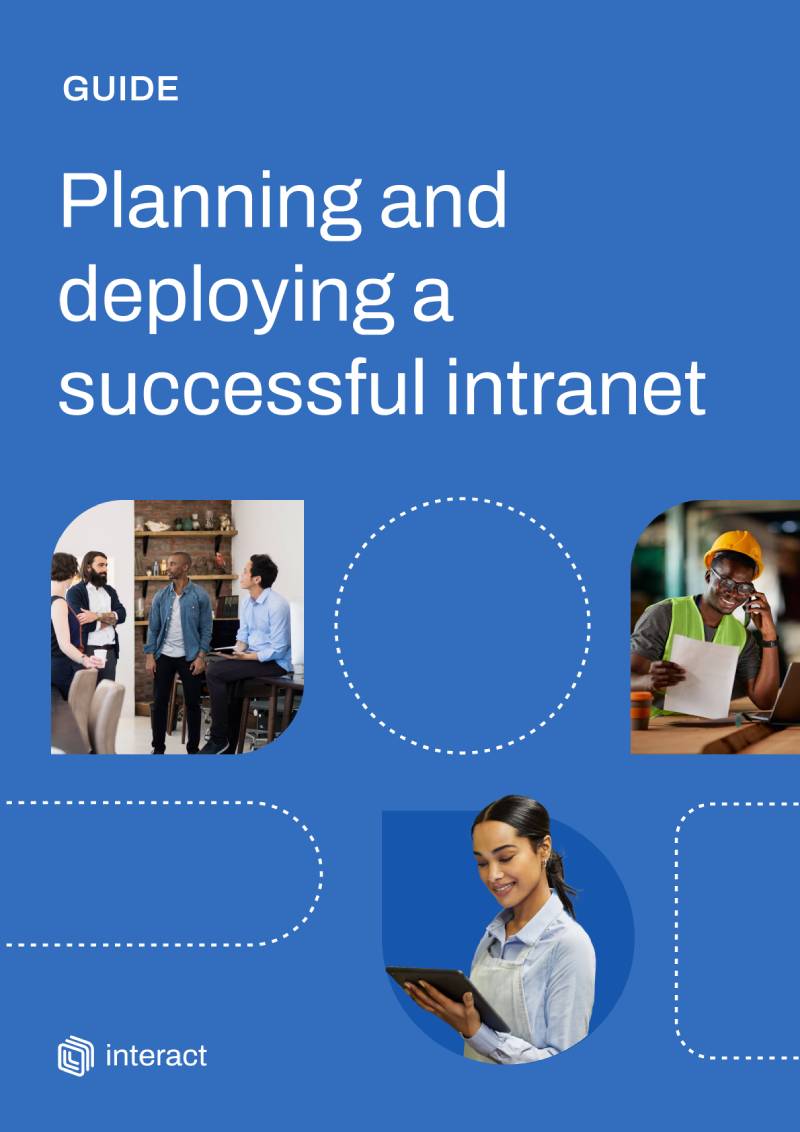When it comes to communicating and informing your organization, the importance of flexibility and accessibility shouldn’t be understated. One thing to consider is a mobile intranet app. Organizations that use mobile apps promote better colleague interactions, and an improved working environment. Apps that support simple and painless communication are good for businesses. They unlock digital transformation faster and connect employees like never before.
We live in a digital age. Companies that want to keep culture fresh are revising their technology requirements and adapting to the needs of staff in several different ways. Apps are already popular in various sectors and are proven to increase and retain users. So why not use them to drive innovative and collaborative communications within the workforce? Have the right tools in place, and the infrastructure to support it. That’s where the intranet app for employee communication has a strategic part to play.
Staying connected

If COVID-19 has taught us anything, it is the importance of staying connected. Having an intranet app creates this easy link between employees, even when they are globally dispersed. Whatever the future holds, apps guarantee that business operations are maintained and the workforce is informed. Perhaps most importantly, culture does not decrease.
Organizations that don’t utilize this technology risk missing out and isolating employees.
Work is generally becoming more remote and flexible. The ability to access an organization’s culture through a mobile device has become the new norm. As simple as checking work emails on a smartphone, it enables users to adapt. Workers stay informed about any new business developments, without ever having to log on to a computer or desktop intranet. Organizations that don’t utilize this technology risk missing out and isolating employees. It is an opportunity to provide alternative channels for staff to engage with each other, alongside an otherwise successful intranet strategy. To have truly frictionless communications that are accessible on the go, a business needs a mobile app.
The rise of the mobile app

Since Nokia created the first mobile app in 1997, the market has gone from strength to strength. Apple’s App Store has 1.96 million apps available to download, and Google’s Play Store has 2.87 million. The general population loves their mobile apps, with the average person having at least eighty downloaded at one time. And employees are no exception.
A study by BuildFire, an app development platform, found that 21% of Millennials open up apps at least fifty times per day. 49% of people open up an app at least eleven times each day. In the US, 69% of all digital media comes directly from a mobile app. They also found that the average smartphone user uses an average of ten apps per day, and thirty individual apps each month.
The mobile app market isn’t slowing down any time soon. Employers are starting to realize the impact that utilizing their own professional app can have on internal communications and collaboration. Any business that doesn’t make this switch and put their culture in their employees’ pocket will lag behind their competitors.
Tasked with improving your internal comms?
Smartphones have become an essential part of a company’s ecosystem. Once supplementary, they are now a necessity to most organizations. From small businesses to global enterprises, smartphones and the technology that accompanies them have proven to be very useful. They process payments, keep track of meetings, record important notes, and are perfect for receiving information on the go. Smartphones connect people, without the need to log on to a nearby laptop or PC.
Flexibility builds culture

Staff can operate from anywhere in the world. Teams span different countries, individuals may work remotely, or perhaps they are traveling on a business trip. At certain points in the day, employees may not have easy access to their intranet or desktop. Mobile devices and an intranet app provide a way to keep in touch and up-to-date with colleagues and business developments with ease. Making sure the intranet is accessible from a tablet, smartphone and desktop keep employees engaged and logging on, whatever their daily routine looks like.
Making sure the intranet is accessible from a tablet, smartphone and desktop keep employees engaged and logging on, whatever their daily routine looks like.
Intranets connect employees, and making that a frictionless process is a key to expanding engagement. For example, the app contains the contact details of everyone in the business. So finding and contacting those from other departments is as easy as sending a text message. Discovering more about colleagues is simple too. User-generated content is available at the touch of a button, simply by logging on. Celebrate life developments and professional achievements with co-workers while sat on the sofa. Get real-time business updates while waiting for a train. Determine the background of an upcoming cultural holiday while having a coffee break. The possibilities are endless.
Encourage use with social features

Apps provide employees with a plethora of ways to communicate and collaborate, increasing that all-important intranet engagement. Classic social features remove the traditional workplace barriers of familiarity, time zone, and technology. The intranet feels familiar, every time workers log on.
Mirroring intuitive and recognizable features of common social media sites, such as Facebook and LinkedIn, provides well-known cues. Employees know exactly what to do and where to go once they log on. Include a Newsfeed to provide real-time activity updates through the device. This is a pathway for every employee to understand and engage with what is happening at a company level. They are aware of the events and updates taking place cross-department and within their own teams. Having this unlimited access from anywhere makes it incredibly easy for everyone to stay informed and work towards a unified business goal.
Tasked with improving your internal comms?
An intranet app encourages collaboration and reduces staff friction, providing easy access for everyone. It’s the key to uniting distributed workers. Whether they are all frontline staff with no time to sit at desktop PC, remote workers who are based all over the world, or office-based and wanting to catch up on their daily commute. Apps drive forward digital network building. They take the challenge away from communications and make it fun, rather than something that employees feel obligated to do.
Native is best

What exactly is a native app? This term means that the app has been created specifically for that mobile operating system (iOS or Android). It can be accessed from their dedicated app store (Google Play Store or Apple App Store). Native apps usually contain features and UX components associated with that system. They feel more tailored than those created to suit both platforms, known as Hybrid or web-based.
There are many benefits of an intranet app that’s created natively. They tend to have a higher level of performance and operation because they are built in a specific code, increasing efficiency and adapting to the device’s visual elements. Native apps run smoother and are recognizable as specific to a particular device. Each operating system has its own unique UX features and functionality.
Native apps are also more secure than their counterparts, particularly once approved by the app store. Apps have access to all of the phone’s security features: two-factor authentication, password protection, and Face/Touch ID. So any company information stored in the app is very safe; inaccessible to eyes that are not supposed to have visibility.
Many websites are accessed via a mobile device are ‘responsive’, which means they are designed and coded to have an optimal mobile user experience. They adapt to the device used. Intranet software is typically responsive if accessed via a mobile device. However, this differs from having an app that is uniquely designed to fit into a specific operating system and is available on the app store. There are many choices when it comes to intranet accessibility for employees. Giving them the most options to explore their workplace intranet opens the door to increasing workplace culture and engagement.
An intranet app to support staff

Internal communications have never been so flexible. Apps provide unique and exciting new channels to reach staff, like SMS and push notifications. Reaching out to employees in this way makes them feel included in the organization’s culture. It ensures that they can adapt to any upcoming business changes. For a more casual communication style, colleagues can post videos and memes, or respond with emojis, to give a real social media feel to their interactions.
Low employee engagement can be a tricky beast to tackle, and sometimes it is challenging to know where to start.
Communicating with multiple employees is never easy, particularly if there are some cultural barriers or a mix of frontline and office-based workers. It can be difficult for a fast-paced organization to encourage employees to stay on top of essential company information and updates without feeling like they are dictating mandatory reads or long meetings. But it’s beneficial when all staff are operating on the same page. Having an employee mobile app available to use is much quicker and easier than checking in on a laptop or PC to the desktop intranet, and it can be done from anywhere, at any time. It’s quite simply the definition of workplace convenience.
Tasked with improving your internal comms?
Low employee engagement can be a tricky beast to tackle, and sometimes it is challenging to know where to start. Particularly as many businesses are operating a remote or hybrid workforce for the first time in response to the COVID-19 pandemic. With mental health issues and feelings of isolation and loneliness on the rise, there has never been a better time to support and connect employees all over the world.
Make download and adoption easy, but safe

When they are away from work, employees have become accustomed to easy-to-use distribution hubs such as Apple’s App Store and Google Play. To better support the widescale download and adoption of intranet apps, software providers should offer the opportunity for company apps to be distributed in this way—although the public nature of this method means it is critical that administrators can still enable or disable user privileges.
If mobile apps are to be used for more sensitive tasks, or an organization wishes to keep their app private, Mobile Device Management (MDM) and Mobile Application Management (MAM) settings can offer alternatives. MDM integration takes place on devices totally controlled by the company (in the same way as IT retains control over company laptops) and is administered privately for inhouse management and control. MAM integration, on the other hand, lets you publish, manage, secure, monitor, and update your intranet app even on devices not owned wholly by the company and in apps downloaded from public sources. This creates greater flexibility and control for organizations where BYOD policies allow employees to work across multiple devices.
Whatever policy suits you best, your employee mobile app provider should be able to accommodate your requests.
Let employees choose

As technology use grows, so do the demands of employees. With tablets, smartphones, smartwatches, and laptops all commonly used across workforces, it makes sense to have some form of mobile technology to support a workplace intranet and connect teams.
In the same token, having a completely mobile-only intranet may not work for some companies, as many employees do still enjoy logging onto a traditional intranet via a desktop. This is particularly pertinent if they spend a lot of time working at a desk or sitting in front of a laptop. What works for one employee may not be right for another, and it’s down to the organization to ensure that all are catered for. If not, there is a risk of a fractured and ineffective communication strategy that only captures a percentage of the target audience, and collaboration will suffer. Don’t forget; the intranet comes in many forms.
Are mobile apps the future of intranets?

Intranets, just like smartphones, are all about getting colleagues to connect. That’s why they make the perfect supplement to delivering digital transformation within workplace communications.
In these uncertain times, when work from home mandates are implemented sporadically across various countries, employers need to be able to contact workers quickly. Mobile apps give employees the tools to access any critical content that they need. Send push notifications or broadcasts to display important developments tailored to the country or area that requires them. It’s certainly quicker than sending tailored emails to different userbases or ringing around individuals to ensure they have the latest health advice from their employer.
When used as part of a structured and well-planned communication strategy, mobile apps can play a vital role in connecting hard-to-reach employees. They encourage collaboration, innovation, and most importantly, they drive workplace culture from the pocket of employees, providing access to content and keeping that connection strong.






